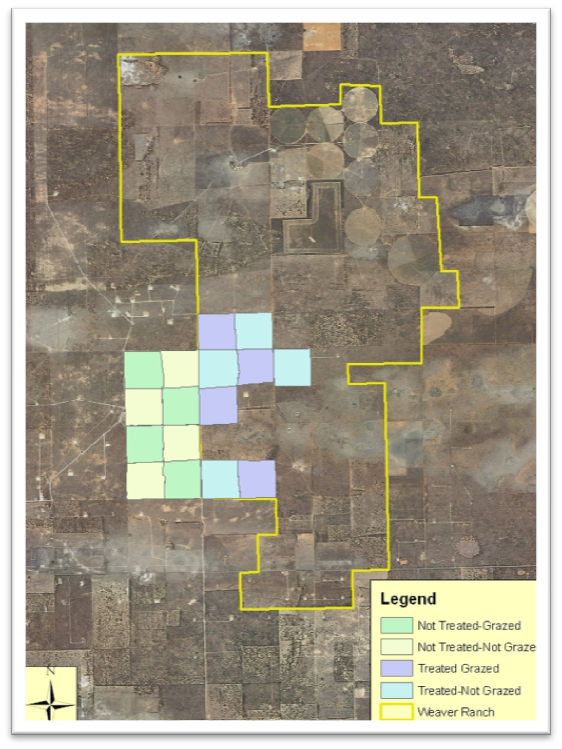Community Response to Use of Prescribed Grazing and Tebuthiuron Herbicide for Restoration of Sand Shinnery Oak Communities
 Investigators:
Investigators:
Jennifer Zavaleta, M.S. 2012
Texas Tech University
Project Supervisors:
Dr. David Haukos
Dr. Clint Boal
Funding:
Grasslands Charitable Foundation
Weaver Ranch
Texas Tech University
Cooperators:
Charles Dixon
Willard Heck
Jim Weaver
Location:
Eastern New Mexico
Completion:
March 2012
Status:
Completed
Objectives:
(1) Determine the community response to tebuthiuron and grazing treatments used to restore sand shinnery oak grasslands.
(2) Assess the temporal response of the community to the treatment combinations over a 12-year period.
(3) Compare resulting vegetation composition to historical standards.
Results:
The sand shinnery oak (Quercus havardii) mixed-grass community is an isolated, relict habitat located within short-grass prairie of the Southern High Plains. With the introduction of center-pivot agriculture, unmanaged grazing, oil and gas exploration and suppression of the natural fire regime, the vegetation composition of the shinnery oak community has changed during the past century. Land managers have used herbicides (e.g., tebuthiuron) and a variety of grazing systems as tools to manage shinnery oak. Results show that at relatively low levels of tebuthiuron (0.60 kg/ha) and subsequent moderate grazing system, sand shinnery oak can be reduced and maintained at near historical levels without reapplying tebuthiuron because the tested management approach allowed grasses to remain competitive in the system. There was 91% less shinnery oak in untreated areas. The removal of shinnery oak made environmental soil moisture more available for grasses and forbs to germinate and grow. Grasses increased by 149% and forbs increased by 257% in treated areas as compared to untreated areas throughout the study period. In terms of visual obstruction, there was both an herbicide and grazing effect in April such that visual obstruction increased by 30% in treated areas as compared to untreated and decreased by 6.5% in grazed areas as compared to non-grazed areas. There was no significant herbicide effect of overall abundance of small mammals. However, there was a significant grazing effect such that there was 23% more abundance of small mammals in grazed areas as compared to non-grazed areas, which was likely driven by kangaroo rats. Areas that were treated with tebuthiuron and had moderate grazing statistically reached historical standards only during one year, but showed trends that were comparable to historical standards throughout the study compared to other treatment combinations. The largest difference between treated areas and historical standards was that treated areas had more forbs. The change from a shrub monoculture to a mixed-grass prairie changes the plant composition and structure and provides more niches for invertebrates, mammals and herptiles to fill.
Products:
Publications:
Zavaleta, J.C., D.A. Haukos, B. Grisham, C. Boal, and C. Dixon. 2016. Restoring sand shinnery oak prairies with herbicide and grazing in New Mexico. Southwestern Naturalist 61:225-232.
Book Chapters:
Haukos, D.A., and J.C. Zavaleta. 2016. Habitat. Pages 99-132 in D.A. Haukos, and C.W. Boal (editors). Ecology and Conservation of Lesser Prairie-Chickens. Studies in Avian Biology (no. 48), CRC Press, Boca Raton, FL.
Technical and Semi-Technical:
Zavaleta, J. 2013. An annotated bibliography of the lesser prairie-chicken. Western Association of Fish and Game Agencies, Tucson, AZ. 550 pp.
Thesis or Dissertation:
Zavaleta, J. 2012. Effects of grazing and herbicide treatments to restore degraded sand shinnery oak grasslands. Thesis, Texas Tech University.
Presentations:
Zavaleta, J., B. Grisham, D. Haukos, and C. Boal. 2013. Invertebrates of sand shinnery oak communities and the influence on lesser prairie-chicken brood survival. Annual Meeting of The Texas Chapter of The Wildlife Society, Houston, Texas.
Zavaleta, J., P. Maloney, and D. Haukos. 2013. Understanding the human component for conservation in the sand shinnery oak grasslands. Annual Meeting of The Texas Chapter of The Wildlife Society, Houston, Texas.
Haukos, D.A. 2012. Restoration of sand shinnery oak grasslands using prescribed grazing and herbicides. Special Session "LCCs: Bridging the science-management gap symposia" 73rd Midwest Fish and Wildlife Conference (Invited), Wichita, Kansas.
Zavaleta, J.C., D.A. Haukos, and C. Boal. 2012. Community response to use of prescribed grazing and herbicide for restoration of sand shinnery oak grasslands. 48th Annual Meeting, Texas Chapter of The Wildlife Society, Fort Worth, Texas.